Spiritual Path
You gotta walk that lonesome valley
You gotta walk it by yourself
Nobody here can walk it for you
You gotta walk it by yourself.
This is the opening stanza of the old folk hymn, "Jesus Walked This Lonesome Valley". The hymn was transcribed by A.J. Carter and recorded in 1923. It has been adapted to meet the needs of many different Christian denominations. It has also crossed over into Folk Music and Blues. My favorite renditions are those by the Carter Family (1923 original version), Woody Guthrie, Pete Seeger and Arlo Guthrie, and Mississippi John Hurt.
Carter Family (A.P., Sarah, Maybell) Radio City Music Hall, 1923
Woody Guthrie
Pete Seeger and Arlo Guthrie in concert
Mississippi John Hurt
SPIRIT WALK
What is a Spirit Walk? According to my Native American ancestors, a Spirit Walk is when you heed the calling of your spirit, journeying where your spirit leads you, so that you may experience that which you need to experience in order to fully realize your reason for being here at this time and in this place.
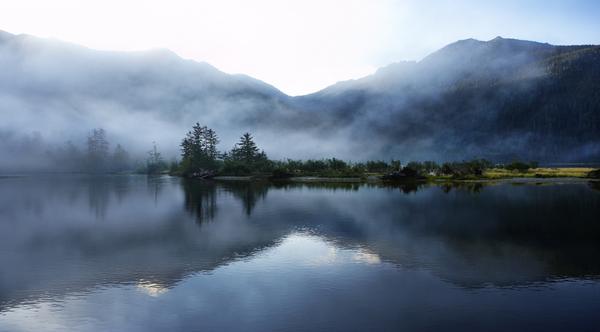
Spirit World Where All Lives, Dies, And Is Reincarnated
A Spirit Walk is living not from ego, but from complete being. It requires that you be totally present and totally accepting, so that old habits and ideas do not continue to foster the illusions that have led you away from your true path.
A Spirit Walk is as much a literal as well as a figurative right of passage. It is a pilgrimage from one state of being to another. While it may involve a journey from what you have come to know as home, it is also a journey to return to the spiritual home that you wandered from in the course of living your life.
A Spirit Walk is not a linear journey. You will journey down many roads and experience many detours, often taking new paths and sometime returning to old ones. In the end, you will find that you have come full circle, returning to where you belong.
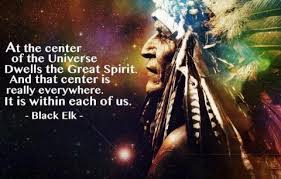
Black Elk
If you turn away from the illusions of the world and reawaken to the awareness of the truth that has always been within you, then your Spirit Walk will return you to the harmony of body, mind, and spirit, that living life seduced you to ignore. That is, it will bring you back to your true way.
The question is, "Do we have only one Spirit Walk or do we have many Spirit Walks?"
Reincarnation is a common belief among many Native American tribes. While this belief is never depicted in Hollywood movies that denigrate the values and beliefs of Native Americans; especially that upon death warriors go the "happy hunting grounds", it fits into the basic Shamanic belief that typifies hunting and gathering peoples wherever and whenever they are found. Moreover, belief in reincarnation is a part of the most ancient elements of human culture.
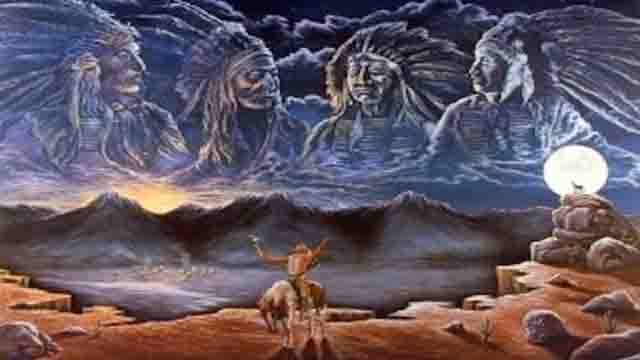
Calling The Spirits
Some Northern tribes believe both animals and human beings are reincarnated. Thus, the physical features of a newborn child are always referenced to those of a dead forebear. Consequently, every child is thus a reincarnation of an ancestral relative.
The tribes of the Great Plains believe reincarnation occurs to allow a soul to be "finished". That is becasue if a soul does not become complete, dies too soon, or fails to successfully transverse a part of the path of life, then it will be sent back to live on this earth again until it completes the journey "in a good way".
New England tribes of which I am in part descended such as the Algonquian, believe reincarnation is one form of afterlife. Like the Narragansetts, the Huron also believe the individual is composed of at least two souls and possibly as many as five. When a person dies, one soul stays near the body until a ceremony called the Feast of the Dead is performed. The Feast of the Dead allows the soul to be set free to be reborn. The other soul went on its own to the Village of the Dead where life continued much as it had prior to the individual's death.
The Northern Athapaskan Dene Tha regard the soul as a dual entity. The soul is believed to remain in the after world and can be prayed to and, at the same time, exists in the human form of the reincarnated individual known as "Those Made Again".
In some instances, reincarnation occurs from human to animal form in the beliefs of the Kwakiutl, Zuni, and Mohave. Yet, they are only one-quarter the rate of human to animal transmigration reported compared to human to human transmigration. However, human to human incarnations also happen to souls that transmigrate from humans to animals. So, for these tribes, one may reincarnate as an animal or human being numerable times.
However, some Native American cultures believe animal transmigration are only for people who do bad things during their human incarnation. For instance, the Yurok fully believe in the transmigration of souls and that they return to earth as birds, squirrels, rabbits, or other small animals to be harried and devoured by larger and stronger animals. Thus, this kind of reincarnation is reserved for wicked people.

Grizzly Bear
The Wintun of Northern California believe the souls of the wicked return in the grizzly bear because the grizzly bear is the most evil and odious of all animals. Therefore, the Wintun will not eat the flesh of the grizzly bear because they are concerned if they do, they would consume a part of the wicked soul.
That said, according to Gary R. Varner in his book, Ghosts, Spirits & the Afterlife in Native American Folklore and Religion from whence the above material may be found, most often reincarnation among Native Americans is viewed as a desirable form of the soul continuing in additional lifetimes whether it is in human or animal form.
As I stated at the end of my book, Reincarnation for Christians: Evidence from Early Christian and Jewish Mystical Traditions, I have had many Spirit Walks. Some of these include many lives as a Native American including one in which I was a Mohawk and participated in the raid on Deerfield, Massachusetts in 1704.
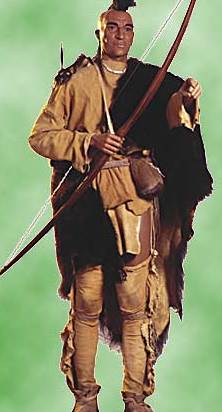
Mohawk Warrior
I know this becasue my father took me fishing in ponds between what is now known as "Old Deerfield" or "Historic Deerfield" and the Deerfield River and at that time, the 1950s, it was still possible to find some of the post holes of the fortified walls around the village that had been preserved. When I stuck my hand in one hole, I felt a shock go through my body and knew I had been there in 1704 as a Mohawk Warrior.
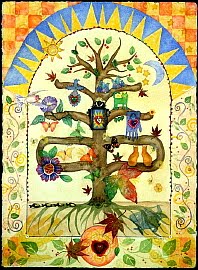
Native American Tree Of Life
Other lives are scattered between Africa, Europe, and America. I was soldier in ancient Egypt, Greece, and the Roman Legion's invasion of England. I was a Highland Scot during several incarnations fighting against the Picts, English, and other Scottish Clans. At another time, I was a Knights Templar and fought in the Crusades. I was also a German soldier in World War I and was killed because I could not get out of the trench during a gas attack.
I was also a member of wagon trains heading West, was a "Mountain Man", and was a sheriff in an "Old West" town. I was a Confederate soldier in the Civil War, wounded in battle, and hid under a pile of dead bodies so I would not be summarily shot the next morning as a "battlefield casualty".
I was also a monk and priest in many different incarnations. In one incarnation, I celebrated High Mass in a beautiful cathedral where I chanted in Greek and Latin. As a monk, I was most often assigned to the scriptorium both to copy manuscripts and as an artist.
SPIRITUAL PATH
Among my earliest memories are going to church with my parents. According to the Anglo-Catholic Catechism of the Episcopal Church, it was our "Bounden Duty" we must attend church every Sunday. To my mother, this was not a suggestion but a mandate from God. So, we attended St. James Episcopal Church every Sunday unless we couldn't get our head off the pillow.
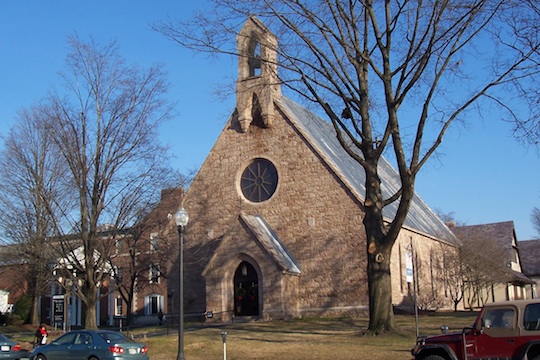
St.James Episcopal Church, Greenfield, Massachusetts
However, my parents were not simply "Sunday Christians". My love of incense was nurtured by three hour Good Friday services and by early elementary school I knew the "Seven Last Words" as well as my own name. My mother was active in the Women's Circle and my father was a canvasser for the Every Member Canvas. Before we went on vacation, we first made a visit to the St. James Chapel for a family Mass and blessing.
As soon as I became old enough, I joined the Children's Choir and became an acolyte. As an acolyte I was a candle bearer, server, thurifer, and crucifer. My senior year in high school I was given the honor of Master Acolyte that meant I trained and supervised the boys who were just becoming acolytes. During elementary school and junior high school, I played the roles of angel, shepherd, Magi, and Joseph in the Epiphany Play. I was elected president of the Episcopal Youth Fellowship in my senior year.
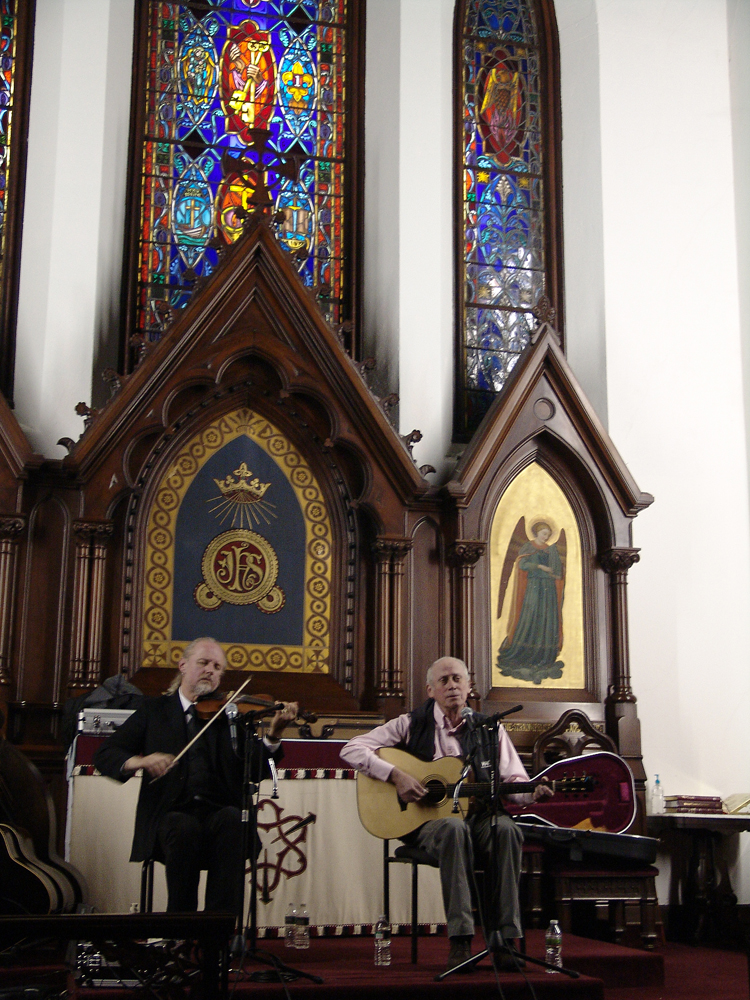
Chancel, St. James Episcopal Church, Greenfield, Massachusetts
There are two events during my time as an acolyte that stand out in my memory.
When I was growing up in the Episcopal Church, the acolyte who turned pages for the priest stood at his side. One Sunday morning when I was 9 years old, as the priest began the Words of Institution that bless the bread and wine where they are transformed by the Holy Spirit into the Body and Blood of Christ, I began to tingle all over much like when your foot falls asleep. At the same time, I could feel my face becoming warm. When I touched it, it was hot. Both of these feelings went away after the priest finished the Words of Institution and held up the chalice and paten containing the consecrated bread and wine for the congregation to see.
When we got home from church, I told my parents what had happened. My father was noncommittal but my mother told me she thought it was God calling me to be a priest and I should tell the priest about what had happened. My mother called to make an appointment for me to see the priest and when I told him what had happened, he told me I had experienced a theophany; that is, God breaking into human history to create a sign that tells us something he wants us to know. Although he agreed with my mother that what I had experienced could be God calling me to become a priest, he also said I could have been called for another purpose. So, I would have to wait as my life unfolded before I could understand the purpose of God's call.
Yet, from that time until I went to college, to my parents and family I had been called by God to be a priest.
The second event I remember is much different. In the Episcopal Church, the bishop of the Diocese comes to each parish once a year to celebrate the Order of Confirmation. Needless to say, that is a major event.
One year when I was in high school, I was the crucifer when the bishop came to celebrate the Order of Confirmation. The robes for acolytes were kept in the choir room and each acolyte's name was on a tag sewn into the back of the collar. This was necessary to be sure the length of the robe was right for each acolyte.
For a reason I can't remember, by the time I arrived at the church the priest, choir, and acolytes were all vested and waiting in the Sacristy for the opening hymn. There was only one acolyte's robe left but as soon as I put it on I realized it was 6 inches too long and dragged on the floor. When I got to the sacristy, the organist was playing the introduction to the opening hymn so there was no time to change robes with the acolyte who had taken my robe by mistake.
The Processional went from the Sacristy up the side aisle to the back of the church and then processed down the center aisle. As it took two hands to hold the Cross, I shuffled my feet hoping I would not step on the bottom of my robe. All went well until I reached the three steps that separated the Naive from the Chancel. As I attempted to climb the steps, I tripped on my robe and fell flat on my face. At the same time, the Cross flew out of my hands like a spear toward the altar landing with a loud "clank" on the floor.
There was no place to hide either myself or my shame so I picked up the Cross, stood at the far end of the choir pews, and turned to face the congregation so that each twosome of the choir could bow in front of the Cross before they turned to go to their pew.
Last in line behind the choir was our priest followed by the bishop. By that time there was no question, Jean etate tres rouge; but, before the bishop bowed to the Cross he gave me a smile and nodded his head "OK".
When I was in junior high school, I had a miracle experience. It was early Spring and the ice on the rivers had broken up but had not yet completely melted. It was on one of the last truly cold days of the year when two of my friends and I, dressed in our heavy winter coats and boots, decided to explore the banks of the Green River as it ran along River Road behind the Franklin County Jail. River Road was a dirt road that was impassable most of the winter.
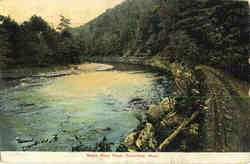
River Road Between The Green River And Franklin County Jail
As we were throwing snowballs at each other we saw something sticking out of the snow. Upon inspection, it was an old wooden trough for mixing cement.
However, to us it quickly became a boat and I was chosen to be its first captain. The plan was I would pole the boat close to shore and at the sandbar around the bend turn my captaincy over to one of my friends. Standing in our sprightly craft, I started poling, but soon the swift current pulled me into the middle of the river. I looked back at my friends who were laughing at me. The boat shot around the bend in the river and as I turned to look downstream, I saw a huge tree had fallen completely across the river. As I hurtled toward it, I saw its branches sticking out in all directions waiting to impale me.
I decided the best thing to do was at the instant the boat hit the tree was to jump and grab hold of its trunk and pull myself up until I could crawl to shore. However, when the boat hit the tree it took a pronounced oblique shift to the right that threw me off balance and into the river.
Instead of jumping where I had intended, I found myself chest deep holding on to the side of the tree's trunk. The shock of the ice cold water paralyzed me both physically and mentally before I fully realized what had happened. I tried to kick one foot over a low hanging underwater branch to begin my climb to the top of the trunk, but the current was so strong I couldn't move my leg. I tried pulling myself up by clutching at pieces of bark, but the bark broke off in my hands.
It was then I realized I was slipping deeper and deeper into the water. Soon the water was up to my chin. Then, beginning like a small prick of consciousness but increasing in intensity until it shut out any other thought, my mind screamed, "You are going to die!"
As I hung on to the tree trunk with the last of my strength, I prayed to God as I had never prayed before: "Help me God, please, I do not want to die. If you save me, I will dedicate the rest of my life to you and become a priest."
Just as I opened my eyes, I saw a man crawling toward me on the top of the tree trunk. When he reached me, he grabbed me with one hand and effortlessly pulled me up beside him. He didn't speak and I crawled behind him until we were standing on the river bank.
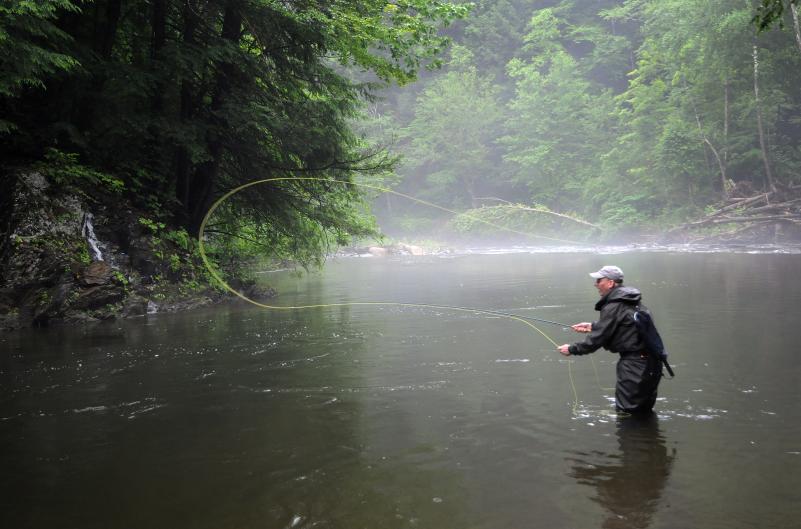
My Favorite Fishing Spot On The Green River
The next thing I remember is standing in the kitchen with my mother trying to explain to her what had happened. I couldn't answer her questions: "Who was this man? How could he see from River Road when I was almost underwater and hidden by the tree? What kind of car did he drive?" "How did I get home?" And most of all, "If this really happened, why are your clothes completely dry?"
The only answer that made sense then, and continues to make sense now, is I had met my Guardian Angel and he had saved my life.
During my freshman year at the University of Tampa, I was elected Vice President of the Canterbury Association which is an organization for Episcopal students as well as its representative to the college's Religious Council.
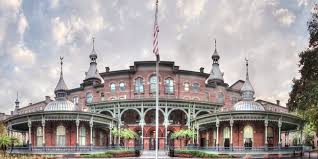
Plant Hall, University of Tampa
In 1887, Tampa, Florida was comprised of a few hundred residents. However, Henry B. Plant who was a railroad and shipping tycoon made Tampa the terminus of his Southern Railroad and the home port of his new steamship line to Havana, Cuba. To accommodate overnight travelers and to provide a world-class hotel for winter visitors, he built the Tampa Bay Hotel in the style of a Moorish Palace at the then enormous sum of $2,500,000. The hotel building, now called Plant Hall, is the main building of the University of Tampa and houses the Henry B. Plant Museum. Famous guests include President Theodore Roosevelt, Queen Victoria of England, Stephen Crane, and Babe Ruth who signed his first Major League baseball contract in the hotel's grand dining room.
Our chaplain encouraged me to apply for the National Council of Churches summer work-study project in Ghana, West Africa. Much to my surprise, I was on of 17 college students from across America accepted to participate in the project.
That summer had a profound effect on my spiritual development. The first week was an orientation in New York City. One of the things drilled into us, and we were given a list of topics, was things we could not talk about. Even if asked a question on any of these topics, we could not answer becasue one never knew if the person you were talking with, or one a group of people, was a member of the Secret Police.
One night, a friend of one of our group invited the three of us to go to Harlem. When we arrived, I discovered we were at a mosque. After being frisked and removing our shoes, we were escorted to our seats. By the time I realized I was the only white person in the room, a man slightly older than me took the podium and began to speak.
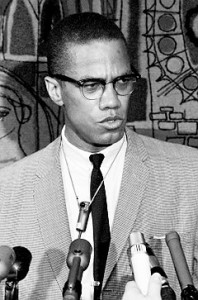
Malcom X
I was shocked! For the next hour and a half I was more than uncomfortable as he preached about slavery, slave names, White Devils, Negro Empowerment, and the demand the United States cede three Southern states to "Negroes" as reparation for slavery, Jim Crow segregation, and all the injustice suffered by his people.
However, his most shocking declaration was Christianity is the White Man's religion imposed on "Negroes" to keep them in their place. In its place, he preached Islam is the one, true religion of liberation, that would meet the spiritual as well as the temporal needs of "Negroes".
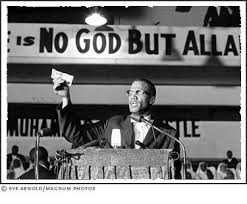
Malcolm X : There is no God but Allah
After the crowd left, the three of us were brought to a back room to meet this man. I learned his name was Malcolm X.
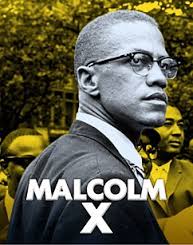
When he looked at me, I felt he could see to the very depths of my soul. For the next hour he spoke of many things and answered all of our questions. By the time we left, I knew I had been in the presence of a man truly touched by God.
We had been told we would experience culture shock in Ghana, but I was still not prepared. Although the people spoke English, by the time we arrived at the small village of Agbosome where we were to build a church and teach in the Anglican School, I realized just how different the next months would be.
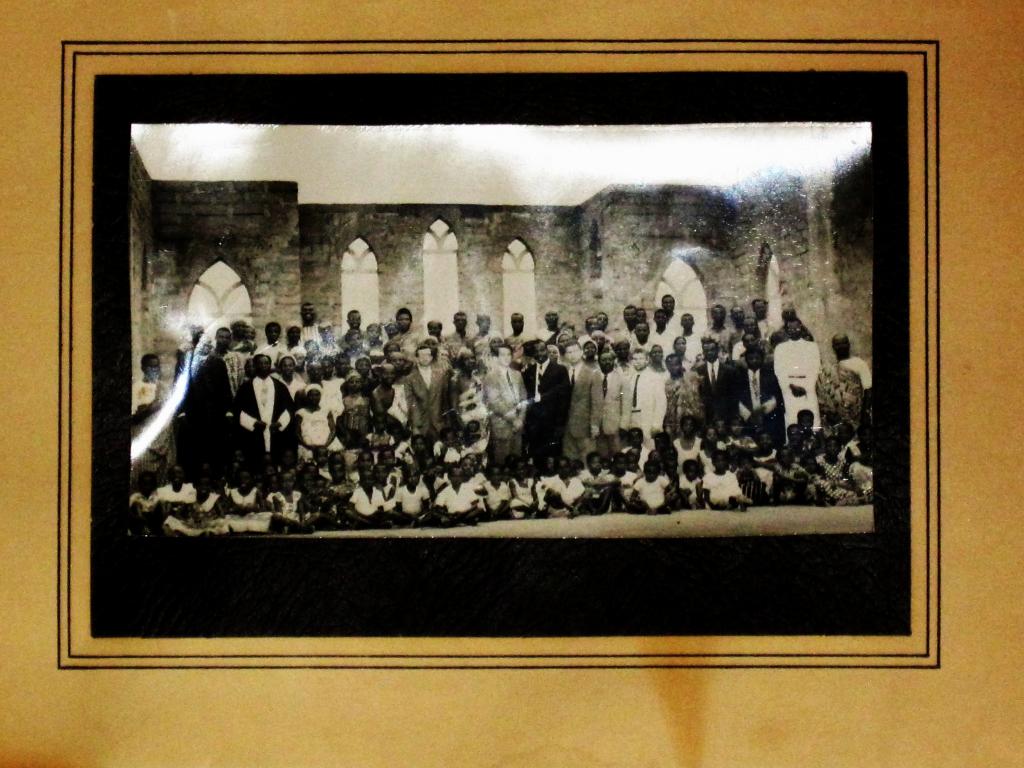
Anglican Church, Agbosome, Ghana
I am the 6th person from the right in the front standing row in the light suit and dark tie.
By the time we left Agbosome, we had completed the foundation, floor, and walls of the church.
Nothing was the same: food, shelter, using an outhouse if available or simply disappearing into the Bush, mixed gender bathing in public using a bucket of hot and a bucket of cold, living with malaria and dysentery, and that most of the time women were naked above the waist.
However, the most striking difference was there were loud speakers that could not be turned off mounted on tall poles that blared propaganda speeches by Ghana's president/dictator, Kwame Nkrumah, from 7:00 a.m. to 9:00 p.m. every day although the speeches were separated by selections of Ghanaian music.
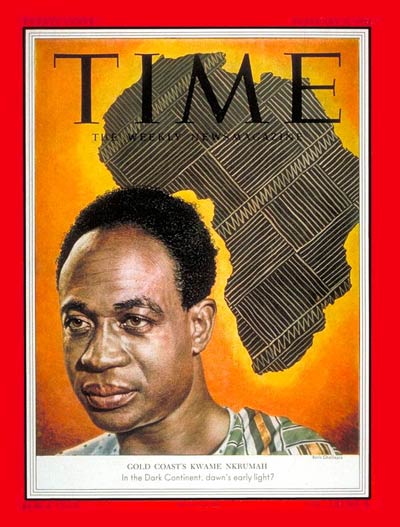
Kwame Nkrumah 1953
Kwame Nkrumah studied in America where he earned graduate degrees in Sacred Theology, Education, and Philosophy. He also earned a doctorate from the London School of Economics. After he returned to Ghana, he organized the Convention People's Party. When Ghana became independent from England on March 6, 1957, Kwame Nkrumah became Ghana's first president and was hailed as Ghana's Osagyefo which means "redeemer" in the Akan language. By the time I arrived in Ghana in 1962, Osagyefo had changed in meaning to "god-king".
Under Nkrumah, Ghana became a client state of the Soviet Union. Nkrumah considered himself to be the "African Lenin" and in 1963 was awarded the Lenin Peace Prize by the Soviet Union. Although closely allied with the political philosophy of Leon Trotsky, Nkrumah is best remembered as the Father of Pan Africanism.
However, as the year passed Nkrumah alienated his base support of working class people as he becasue more dictatorial. While he was on a state visit to Vietnam and China in 1966, he was overthrown by a military coup and lived the rest of his life in exile.
My first reaction was how primitive and atavistic this country and these people were. However, as I learned over the next weeks and months, nothing could be farther from the truth.
I gradually became aware of the deep spirituality of the Ghanaian people. Despite crushing poverty and a totalitarian government ruled by a despot, there was no question the light of Christ burned brightly in their soul.
I also learned the true meaning of hospitality. It was a hospitality not born of obligation or duty, but rather the kind practiced when each person regards the other as being the image of Christ. I discovered the material markers of success, happiness, and joy, are measured by a love of God, a love of family, and a generous spirit without regard to self.
I experienced Ghanaian hospitality in a very personal way. Part of the time our group was divided into groups of 3 and we traveled throughout Ghana. My group was visiting a small village deep in the Bush when as a consequence of malaria and dysentery I became too ill to travel. It was agreed I would stay in the village and when I was able, I would catch up with my friends.
I was put in a small hut and and placed on a grass mat; that is, a Ghanaian bed. As I drifted in and out of consciousness, I remember every time I was conscious--day or night--a teenage girl sat beside me on the ground with either a compress on my head or changing what can best be described as my diaper.
When I was well enough to travel, the entire village of about 50 people was there to send me off. I thanked everyone for taking such good care of me but as I was in the middle of thanking them, the village chief stopped me. He stepped forward and told me it had been the village's honor to be able to nurse me back to health and it was they that owed a debt of gratitude, not me.
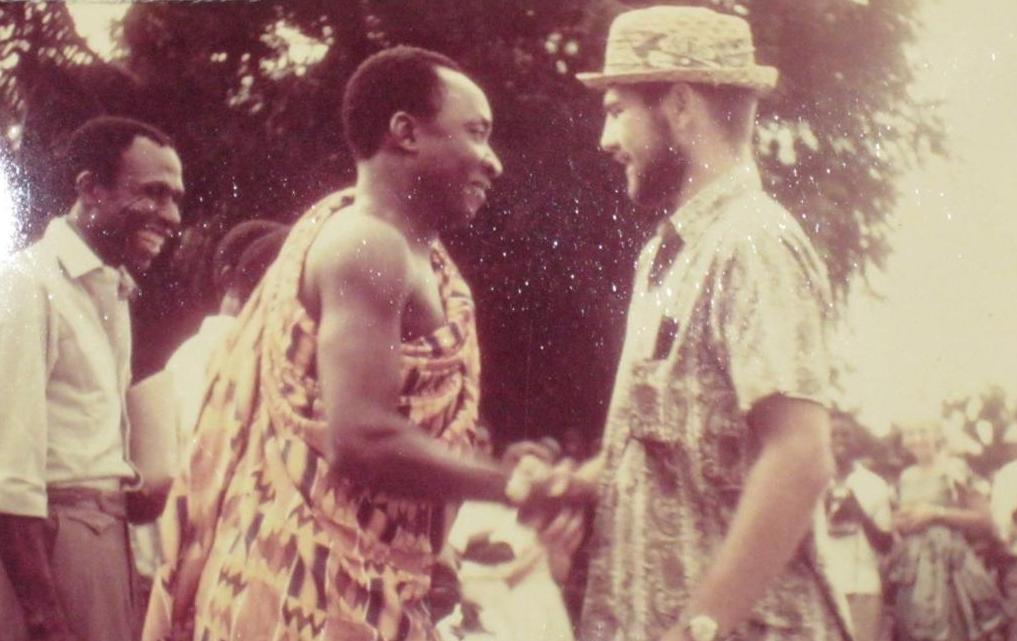
The Village Chief Of Agbosome, Agabadeptke, and I Exchange Fond farewells
The man on the left was our government liaison, who in fact was a member of the Secret Police
We were told that in Ghana, it is customary to give a small gift to your host when you depart. Chief Agabadeptke had admired my hat, so before I left I gave it to him.
By the time I returned home, I realized these "primitive" and "atavistic" people had taught me more about what it means to be a Christian and member of the human race than all the efforts of my parents and church.
I wasn't aware of it at the time, but my freshman year in college had been the beginning of a long quest to obtain my bachelor's degree. Although I remained active in the Episcopal Church, my thought of becoming a priest was pushed aside by poor grades, work, marriage, and relocation.
While I was a student at the University of Tampa, I met a young woman who was a student at the University of South Florida about 25 miles away. The University of Tampa and the University of South Florida shared the same Episcopal Chaplain and he needed someone to be the resident student at the newly build Canterbury House at the University of South Florida.
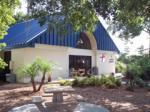
Canterbury House
I was more than happy to accept his invitation to assume the position so I transferred to the University of South Florida. When I was a student at the University of South Florida's founding Temple Terrace Campus (1962-1963), it was the second year of the university's existence. At that time, there were only a few buildings: administration, liberal arts, science, library, men's dormitory, and women's dormitory.
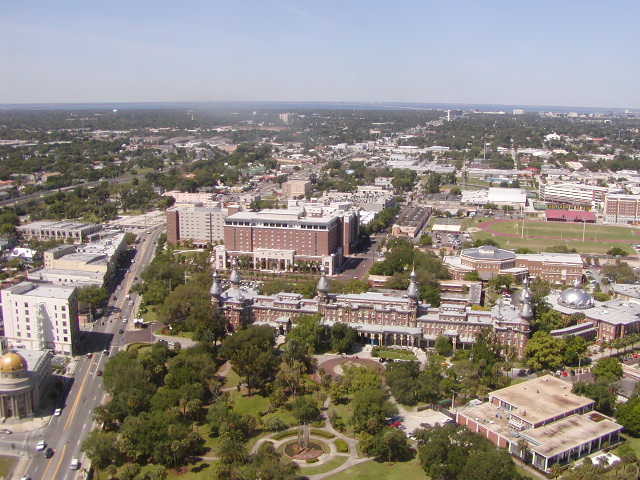
University Of South Florida Temple Terrace Campus Today
The photo above is a part of the Temple Terrace Campus today and there are several more campuses in the Tampa - St. Petersburg area. Today the University of South Florida has a full range of men's and women's intercollegiate athletic programs and teams. However, that was not the case when I was a student becasue one of the political trade offs with the Regents of the University of Florida and Florida State University was the University of South Florida would not have intercollegiate athletics for the first 25 years of its existence.
However, Evangelicals had stepped into the vacuum to provide students with Evangelical sponsored programs designed to brainwash students into becoming Evangelicals and political conservatives. Consequently, the only available student extra-curricular activities included Youth for Christ founded in 1946 and Campus Crusade for Christ founded in 1951, both by Evangelical organizations.
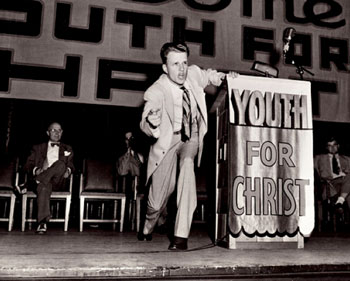
The Rev. Billy Graham, Youth For Christ's First Full Time Paid Staff Member
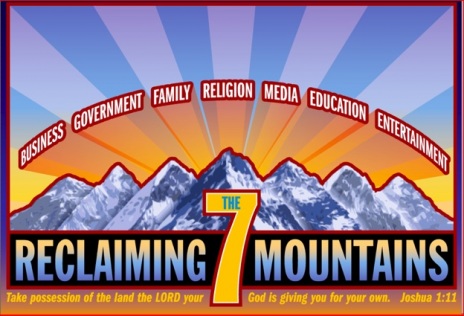
Campus Crusade for Christ founded in 1951 by Evangelical Bill Bright,
Campus Crusade For Christ Teaches Only Evangelicals Are Entitled To Control The 7 Mountains
There was also one political organization for students. Young Americans for Freedom was founded in 1960 at the home of William F. Buckley, Jr. where they adopted the Sharon Statement to advance the political policies of conservative Republicans.
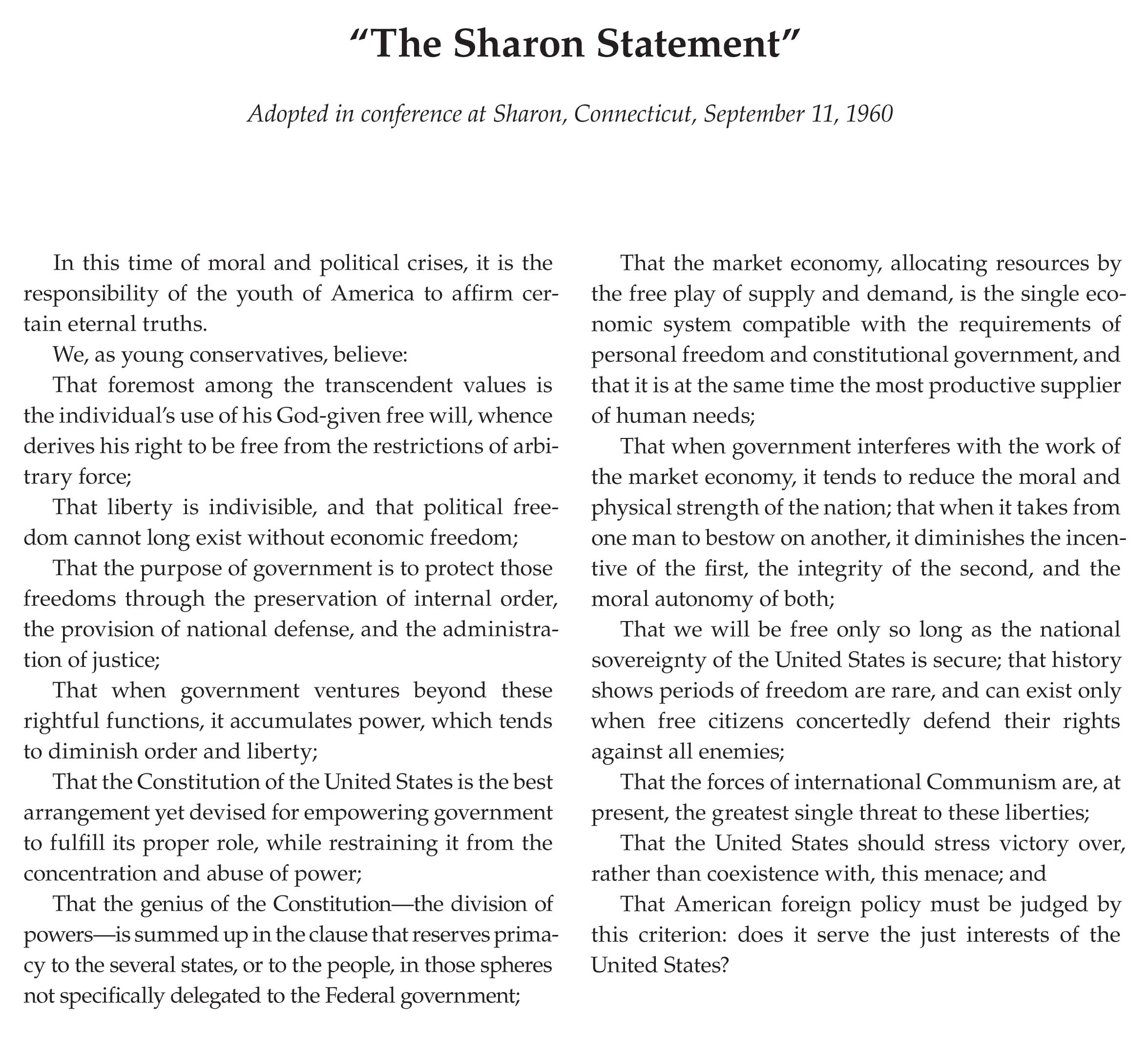
The Sharon Statement
Given the Sharon Statement, it is convoluted "conservative logic" regarding Conservative political statements and positions on issues, especially abortion, that blinds them to the fact being Pro-Life does not grant a freedom. On the contrary, it takes a Constitutionally protected freedom away from women; that is, it takes away the sanctity of a woman's body and her freedom to determine her own reproductive decisions.
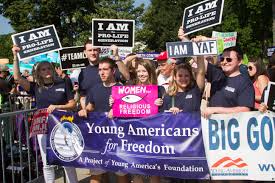
Young Americans For Freedom "Firing Up America Tour"
Of course having grown up in the Anglo-Catholic wing of of the Episcopal Church in a part of the Country that was Evangelische Freikirche (Evangelical free) in the 1950s, I had no idea what these organizations were about but they sounded like I would enjoy them. So, I joined all three my first trimester at the University of South Florida.
To make the proverbial long story short, I was quickly dismissed from Youth for Christ because I was not "born again" and "did not know Jesus in my heart". Thereafter, I had the good sense to drop out of Campus Crusade for Christ before I was asked to leave. That left Young Americans for Freedom, but I soon learned not all "Young Americans" are created equal and my idea of freedom was not theirs because they had no use for my "socialist ravings" and soon asked me to leave.
However, there was one bright spot among the rot of these Evangelical and political right-wing organizations and that is I was chosen by Dr. Henry Winthrop, the head of the Social Science Department, to be his student assistant for the year. Dr. Winthrop was the first world-class scholar I had met and I own him a tremendous debt of gratitude becasue it is he who taught me how to do professional level academic research and writing.
Additionally, I am very grateful for his example of how one should respond to the irrational accusations, propaganda, and pogroms of America's Radical Right Wing.
I say that because the tyranny I experienced with Dr. Winthrop was by the end of the year a sucker punch to the stomach. The back story is a female student whose father was a Florida State legislator told her father the campus was overrun with communists and homosexuals. He in turn requested the Johns Committee investigate the University of South Florida as they were already investigating the University of Florida and Florida State University for the same reason.
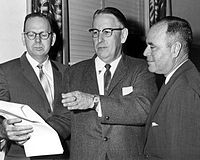
Committee Chairperson Charley Eugene Johns In Center
The Johns Committee had been established in 1956 at the height of the communist "Red Scare" and was named after former governor and first chairperson Charley Eugene Johns. The Johns Committee was created to investigate subversive activities by college professors, civil rights groups, suspected communists/organizations, as well as to identify homosexuals in state government and on college campuses.
It is to be noted, the Johns Committee was established two years after the Army-McCarthy Hearings that totally discredited Senator Joseph R. McCarthy's witch hunt for finding communists behind every tree and bush to say nothing about within Congress and the Judiciary.
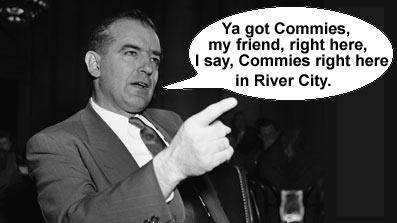
Senator Joseph McCarthy
The high point of the Hearings, and the final nail in Senator McCarthy's credibility, was the famous rebuke given him by the attorney for the Army, Joseph Welch, "Have you no decency, Sir? At long last, have you no decency?"
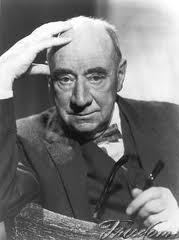
Joseph Welch
Three members of the Johns Committee were in residence for most of the academic year. They interviewed administrators, faculty, and students using the same tactics the recently discredited witch hunt of Senator Joseph McCarthy had used of intimidation, fear, guilt by association, and most egregiously lies, lies, and more lies, in their attempt to learn the names of all on campus who were communists, communist sympathizers, or who were homosexuals.
The penalty for not cooperating with the Johns Committee by giving them the names, whether or not you believed them to be communists, communist sympathizers, or homosexuals, was to be branded as one yourself by the Johns Committee.
To carry out its mandate, the Johns Committee spread attempted to spread terror among communists, if any existed, and socialists such as myself, as well as closeted gays and lesbians by using Gestapo tactics. One tactic was for uniformed police officers to pull students and professors out of class for interrogation. Admission of a being communist, socialist, or sympathizer, as well as being gay or lesbian, constituted a violation of "moral turpitude" and was grounds for administrators and faculty to be fired and for students to be expelled.
The one exception was gay and lesbian students could continue their education providing they:
1. Abstained from all sexual activity on and off campus.
2. Submitted to "treatment" by the Student Health Center until they graduated to make them straight.
To ensure these conditions were adhered to, the Johns Committee had the right to seize any student's medical record and use it as they pleased.
In addition to holding interviews, the Johns Committee also sat in on classes looking for faculty who by what they lectured could be construed as communists or homosexuals and students, by what they said in class discussions, could be swept up in their communist and homosexual net.
It is here that Dr. Winthrop was sucker punched by the Johns Committee because at that time in American higher education, every college or university that wanted to be highly ranked had to have at least one Marxist Scholar on the faculty and for the the University of South Florida that Marxist Scholar was Dr. Winthrop. And, as one of the primary methods the Johns Committee used was "guilt by association", as Dr. Winthrop's student assistant I was as guilty as was he of being a communist or communist sympathizer.
In fact, the Johns Committee was so fixated on the tide of the "Red Menace" engulfing the campus, they checked every book in the library and any book that had the word "red" in the title such as The Red Badge of Courage or even Little Red Riding Hood (education was the only major the university offered that year), was removed from the shelves. They also removed science books that in any way referenced human sexuality or human reproduction and did the same for textbooks in science courses on the grounds they were, "communist and homosexual inspired pornography".
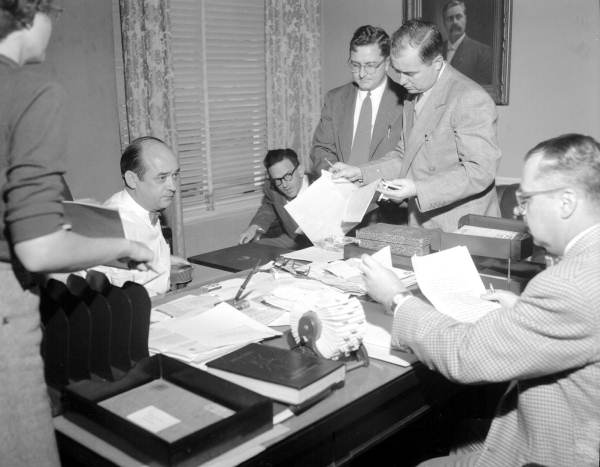
The Johns Committee At Work
Reviewing Reports Of Professors Wearing Bermuda Shorts On Campus, Same Gender Faculty And Students Sitting Too Close Together While Eating, And Professors And Students Who Exhibited "Effeminate Mannerisms"
The Johns Committee was also highly critical of the university's policy of scheduling speakers they considered "known Communists or Communist sympathizers", teaching evolution to the exclusion of the Creation story in the Book of Genesis in the Bible, assigning "obscene" books of "intellectual garbage" such as J.D. Salinger's Catcher in the Rye and "trashy and pornographic" books such as John Steinbeck's, Grapes of Wrath and Aldous Huxley's, Brave New World as text books. The Johns Committee was particularly outraged by English Professor Sheldon N. Grebstein and immediately suspended him after denounced him for handing out "indecent" reprints of literary criticism of the works of Beat poets and writers such as Alan Ginsberg.
At the end of the year, we were all to learn the effect this toxic stew of Evangelical faith beliefs coupled with conservative Republican political beliefs would have on the university, its administrators, its faculty, and its students. The effect was hundreds of students were notified they could not return to the University of South Florida the next year; or, to any university run by the State of Florida. The same ultimatum was given to several members of the faculty and administrators.
The bottom line was all of those considered by the Johns Committee to be communists, communist sympathizers, or homosexuals had been tarred by the same brush, the Johns Committee, with no right to confront their accuser and no right to appeal the decision of the Johns Committee.
In 1964, the Johns Committee issued its report on its investigations titled, Homosexuality and Citizenship in Florida. As a consequence of its cover color, it informally became known as "The Purple Pamphlet".
.jpg?1470840659679)
Cover Of
Homosexuality and Citizenship in Florida
The conclusions of the Johns Committee were:
1. There were at least 60,000 homosexuals living in Florida.
2. Homosexuals have an insatiable appetite for sex.
3. Homosexuals find much gratification in bring over (recruitment) of innocents to homosexuality.
4. Everything possible must be done to keep the hands of homosexuals off of children.
5. "Children" should read the report to prepare themselves to meet the temptation of homosexuality lurking in every institution of higher learning.
6. The University of South Florida was inundated with communists, communist sympathizer, and socialists that must be excised like a cancer so they cannot contaminate the university and bring it down to "their level"; worse still, trick innocent students to turn away for the Christian America God had created and turn them into communists, socialists, and homosexuals.
When state legislators saw the cover of, Homosexuality and Citizenship in Florida, they were outraged at what they considered "state sponsored pornography" and forbade any further printing of it. They also eliminated any further funding for the Johns Committee and it ceased to be a Legislative Committee on July 1, 1965. However, during its existence the Johns Committee had amassed 30,000 secret documents the Florida legislature ordered sealed for 72 years. In 1993, as a consequence of pressure from historians and Florida's public records law, the documents were photocopied with all the names blacked out except for the Johns Committee members and staff of the Committee. These documents are available for public viewing at the Florida State Archives.
Many people considered it the perfect squelch that the Johns Committee, which had been commissioned to root out homosexuality on college campuses, had been destroyed by the homo-erotic image of two men kissing on the cover of its report on homosexuality, Homosexuality and Citizenship in Florida. However, by that time the Johns Committee was dissolved the damage had been done, untold numbers of people had their lives destroyed, and one professor who was a married man attempted suicide after his interview because the Johns Committee accused him of being a homosexual.
Yet, in a 1972 interview Charley Johns stated of the Johns Committee, "If we saved one boy from being made a homosexual or a communist, it was worth it" and held this position until his death.
As an aside, it is more than chilling that 42 years after Charley Johns' statement the mantra of the Pro-Life Movement is, "If we save one baby from being aborted, it is worth it."
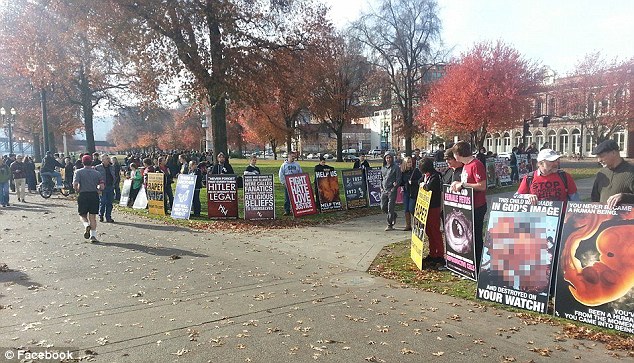
Abolish Human Abortion Volunteers With Posters Of Aborted Fetuses
Abolish Human Abortion members encouraging volunteers to "kidnap abortion-minded women on the way to abortion clinics" and drop them off at churches
The Florida State Legislature finally came to its senses and saw the Johns Committee for what it was: An immoral, unethical, and unconstitutional intrusion into the private lives of its citizens and the sole effect of the Committee was to negatively impact on and ruin the lives of the very citizens the state had the obligation to protect.
One can only hope that in time Pro-Life Zealots, who do everything they can to undermine legal abortion and make it unconstitutional, see it for what it is: intrusion into the private lives of women that has the sole effect of negatively impacting on and ruining their lives.
By the end of that year at the University of South Florida, my eyes had been fully opened to the danger posed to both individual rights and liberties as well as the nation by Evangelicalism, Evangelicals, Conservatives, and the Republican Party.
Unfortunately, what I experienced at the University of South Florida was just the tip of the emerging iceberg that first morphed into the presidency of Ronald Reagan, then George W. Bush, and today manifests itself as the Tea Party Movement all of which have done irreparable harm to America and Americans as well as pushed our nation so far to the right we are well down the road of American Fascism.
And, it is this unrelenting push to the religious and political right by Evangelicals and their Roman Catholic cohorts that created the Tea Party that has created the Congress that has the lowest rating of any Congress in United States history. Moreover, it is this same movement that is responsible for the divisiveness, fear, and anger that now engulfs America that has made it possible for the completely and utterly unqualified Donald Trump to become the Republican nominee for president.
People sometimes ask me why I get so incensed when I hear Conservative Roman Catholics, Evangelicals, Political Conservatives, and Tea Party Republicans claim America was founded on Christian faith beliefs and the Founding Fathers created America as a Christian Nation.
The answer is their claim is a bald-faced lie. Yes, a bald-faced, self-serving lie of the largest proportion. And, I can prove this is true becasue one of the courses I took at the University of South Florida was Early American History and one of the things I learned in that course was many of our most famous Founding Fathers were not Christians. More importantly, they condemned Christianity in the most striking statements possible.
Here are a few such statements:
Let us begin with the words of one of America's most noted historians, Robert T. Handy.
Handy wrote:
Our Founding Fathers broke away from traditional religious thinking. The humanistic philosophical writers of the Enlightenment such as Locke, Rousseau, Voltaire, and Isaac Newton's mechanical and mathematical foundations served as their grounding point. A few Christian fundamentalists attempt to convince us to return to the Christianity of early America, yet no more than ten percent--probably less--of Americans in 1800 were members of religious congregations.
Handy's contention is supported by Joel Barlow, Counsel to Algiers who was responsible for the treaty negotiations and for writing the Treaty of Tripoli. He wrote:
As the government of the United States of America is not in any sense founded on the Christian religion... (See: Treaty of Tripoli, Article ll, ratified by the United States Senate, June 10, 1797, written by Joel Barlow, Ambassador to Tripoli).
Barlow later clarified, as if any clarification was necessary:
Here we have a clear admission by the United States that our government did not found itself upon Christianity.
Thomas Jefferson in a letter to Ezra Stiles Ely on June 25, 1819 stated:
You say I am a Calvinist. I am not. I am of a sect by myself, as far as I know.
John Adams in a letter to Thomas Jefferson stated:
I almost shudder at the thought of alluding to the most fatal example of the abuses of grief which the history of mankind has preserved--the Cross. Consider what calamities that engine of grief has produced!
Thomas Jefferson, in a letter interpreting the First Amendment to the Danbury Baptist Association on January I, 1802, wrote:
I contemplate with sovereign reverence that the act of the whole American people which declared that their legislature should "make no law respecting the establishment of religion, or prohibiting the free exercise thereof" builds a wall of separation between church and state.
James Madison in his letter to Edward Livingston on July 10, 1822 states:
And I have no doubt that every new example will succeed, as every past one has done, in showing that religion and Government will both exist in greater purity, the less they are mixed together.
James Madison wrote the Memorial and Remonstrance against Religious Assessments in 1787. In it he states:
During almost fifteen centuries has the legal establishment of Christianity been on trial. What have been its fruits? More or less in all places, pride and indolence in the Clergy, ignorance and servility in the laity; in both, superstition, bigotry and persecution.
In another place in the document, Madison states:
What influence, in fact, have ecclesiastical establishments had on society? In some instance they have been seen to erect a spiritual tyranny on the ruins of civil authority; in many instance they have been seen upholding the thrones of political tyranny; in no instance have they been the guardians of the liberties of the people. Rulers who wish to subvert the public liberty may have found an established clergy convenient auxiliaries. A just government, instituted to secure and perpetuate it, needs them not.
Thomas Jefferson in his letter to Peter Carr on August 10, 1787 wrote:
Question with boldness even the existence of god. (lower case "g" as Jefferson wrote it)
Dr. Priestley, an intimate friend of Benjamin Franklin wrote in his, Autobiography:
It is much to be lamented that a man of Franklin's general good character and great influence should have been an unbeliever in Christianity, and also have done as much as he did to make others unbelievers.
Thomas Paine in, The Age of Reason wrote:
Of all the systems of religion that ever were invented, there is no more derogatory to the Almighty, more unedifying to man, more repugnant to reason, more contradictory to itself than this thing called Christianity.
In reference to The Virginia Act for Religious Freedom cited in Thomas Jefferson's, Autobiography he states:
When the preamble declares, that coercion is a departure from the plan of the holy author of our religion, an amendment was proposed by inserting "Jesus Christ", so that it would read, "A departure from the plan of Jesus Christ, the holy author of our religion"; the insertion was rejected by the great majority, in proof that they meant to comprehend, within the mantle of its protection, the Jew and Gentile, the Christian and Mohammedan, the Hindoo and Infidel of every denomination.
The French aristocrat Alex de Tocqueville had toured America for over a year wrote in his, Democracy in America dated 1835:
They all attributed the peaceful dominion of religion in their country mainly to the separation of church and state. I do not hesitate to affirm, that during my stay in America I did not meet a single individual, of the clergy or the laity, who was not of this same opinion on this point.
We will close these quotations with that of another historian, Robert Middlekauff, who wrote:
The idea that the Constitution expressed a moral view seems absurd. There were no genuine Evangelicals in the Convention, and there was no heated declaration of Christian piety.
This statement by the historian Robert Middlekauff that there were no Evangelicals at the Constitutional Convention is the smoking gun that proves when Evangelicals claim, as a consequence of like-believing Christians at the Constitutional Convention, America was created according to their Christian faith beliefs and that America was created to be a Christian nation, such claims are nothing but a self-serving lie on their part to destroy the Constitutional separation between Church and state. They do so becasue it is their religious-political agenda to remake America into a theocracy in their image obliterating any line between the separation of Church and state.
To put an exclamation point on the fact the Founding Fathers did not create America according to Christian faith beliefs or intend it to be a Christian nation, all we need to know is that after the first three weeks of the Constitutional Convention that had sailed smoothly ahead, the discussion hit the rock of States Rights. After several days of contentious accusations and debate, Benjamin Franklin rose and made two suggestions. The first suggestion was each day begin with a prayer. The second suggestion was a three day recess be called wherein the delegates would only talk with members on the other side of the States Rights issue so that each side could fully understand the other.
This is what happened:
1. A Prayer Committee was appointed to study having each day begin with a prayer.
2. A three day recess was held after which States Rights was no longer a contentious issue.
3. According to the records in existence, the Prayer Committee either did not meet or the vote to begin each day with prayer was rejected, because there is no record of the Prayer Committee's report. Most importantly, after the recess not one day of the Convention began with a prayer.
Finally, Conservatives, the Religious-Right, and Tea Partiers, make much of our nation's motto,"In God We Trust" on our money as proof the Founding Fathers founded America on Christian faith beliefs and intended it to be a Christian nation. However, the fact is that is just another Right-Wing lie.
Here is the truth of the historical development of our national motto and why and when it began to be used on our money.
1. January 18, 1837: An Act of Congress prescribes the mottoes and "devices" that can appear on coins and paper money. The phrase, "In God We Trust" does not appear in this Act.
2. November 13, 1861: The Rev. M.R. Watkinson, "Minister of the Gospel" from Ridleville, Pennsylvania, wrote a letter to the Secretary of the Treasury Salmon P. Chase telling him in light of the Civil War and that God protects America, the phrase "In God We Trust" should be added to our currency.
3. April 22, 1864: "In God We Trust" first appears on the two-cent coin.
4. March 3, 1865: An Act of Congress authorizes "In God We Trust" to appear on limited gold and silver coins.
5. 1833, 1901: "In God We Trust" is missing from several denominations of coins.
6. July 30, 1956: President Dwight D. Eisenhower approved a Joint Resolution of Congress declaring "In God We Trust" our national motto.
7. 1957: The first use of "In God We Trust" used on paper money.
The bottom line is when I hear Conservative Roman Catholics, Evangelicals, Political Conservatives, and Tea Party Republicans, claiming the Founding Fathers created America predicated on Christian faith beliefs and intended it to be a Christian nation, or hear them claim the Founding Fathers coined our national motto, "In God We Trust", I am repulsed for two reasons.
The first reason is if they know the truth as cited above, their claims are nothing but lies, lies, and more lies used to support a religious belief system, political ideology, or both.
The second reason is if they do not know the truth as cited above, they are making claims out of ignorance. However, ignorance is no excuse and they should be ashamed of themselves for being too lazy or too brainwashed to turn on their computer and educate themselves.
Within a year of earning my bachelor's degree, I had earned my first graduate degree and was appointed to the faculty of Baltimore City Community College. I enjoyed teaching, but soon became restless. My mind kept returning to thoughts of priesthood.
When I discerned it was the right time, I approached Bishop Harry Lee Doll of the Diocese of Maryland, went through the evaluation process, was accepted as a Postulant, and applied to General Theological Seminary in New York City.
Bishop Harry Lee Doll
After a visit over Christmas Vacation, I was accepted as a seminarian. However, Bishop Doll told me he could only offer financial assistance if I went to seminary at Virginia Theological Seminary. As my belief system was Anglo-Catholic (High Church), I told Bishop Doll I did not feel I could attend a Protestant Episcopal (Low Church) seminary and declined his offer. He told me the door would always be open.
Two years later, Bishop David Leighton, Jr. succeeded Bishop Doll and he agreed to send me to General Theological Seminary.
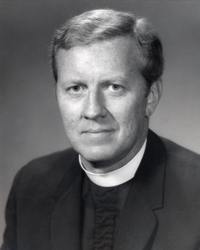
Bishop David K. Leighton, Jr.
I resigned my faculty position at Baltimore City Community College and put my house on the market. The next week, I received a letter from Bishop Leighton stating he had scheduled me for an updated psychological evaluation. Shortly thereafter, I received a letter from him stating he had withdrawn his support but no reason was given. The letter stated I could go to seminary, but there would be no financial assistance and there was no guarantee of ordination when I returned.
When Bishop Leighton finally agreed to meet with me, he told me the reason he had withdrawn his support was I had told the psychologist I had been in an adversarial relationship with my mother since I was seven years old. He then told me he could not have a priest who did not love his mother.
I told him the issue had nothing to do with not loving her. I reminded him I was adopted and the fact was there could not be two more mismatched people in terms of emotion and world-view; and consequently, more antagonistic to one another than my mother and I.
I asked the bishop if he was saying I was being denied priesthood for being honest. His response was, "yes". He then told me if my mother and I reconciled, and she sent him a letter to that effect, that would remove my "impediment" and he would resume his support for me to go to seminary and ordain me to the priesthood when I returned.
I told him even if I was willing to reconcile, my mother would never do it or send him a letter to that effect.
I was bitter and angry. I felt the bishop was unfair. I was devastated and felt betrayed by the church I loved so dearly. In my heart I knew God had called me, and continued to call me, to priesthood. My feelings of anger and betrayal were so great, I stopped going to church for several years.
During the middle 1970s, my wife was a member of a music ministry in a Roman Catholic Church and I volunteered to play guitar. A few years later, she decided to join the Roman Catholic Church and with no hope of becoming a priest in the Episcopal Church, I joined her.
I spent the next 25 years as a practicing Roman Catholic performing in several different parishes. However, my interest in theology soon returned. As soon as I could, I took a sabbatical leave from teaching and attended St. Mary's Roman Catholic Seminary as a student in the School of Theology through St. Mary's Ecumenical Institute. When that year ended, I resigned my faculty position and stayed at St. Mary's where I earned a graduate degree in theology.
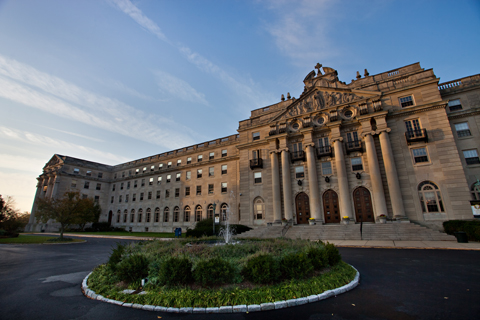
St. Mary's Roman Catholic Seminary, Baltimore, Maryland
St. Mary's Seminary is the oldest Roman Catholic seminary in America. It was established in 1791 and is America's only Pontifical Seminary.
My experience at St. Mary's confirmed to me God was still calling me to priesthood. But, how could this be? I was settled in the Roman Catholic Church, married, and had three children. I investigated the Permanent Diaconate, but discerned it was not for me. Yet, no matter how hard I tried, I could not put priesthood out of my mind. In my soul, I knew God was still calling me to priesthood.
St. Mary's Seminary Chapel
I had always enjoyed writing and in 1995 decided I would put my seminary years to benefit by writing a book. However, to be credible I knew I needed a doctorate. The closest university that offered a doctorate in theology was Catholic University of America. However, it was an hour's drive away and would require attending classes 3-4 nights per week for three years and then write and defend my dissertation which would take another year.
I did not feel that would be fair to my family, so I began to search the Internet for a seminary where I could earn a doctorate by distance learning. I soon discovered there were several, but they were all Evangelical. Then one night, my wife called me to her computer. On the website was the question, "Do you want to become a Catholic priest?"
My wife had found the website for the Catholic Apostolic Church of Antioch-Malabar Rite (Church of Antioch). The page had a link to Sophia Divinity School which is the seminary of the Church of Antioch and it offered a Doctor of Theology Degree by distance learning.
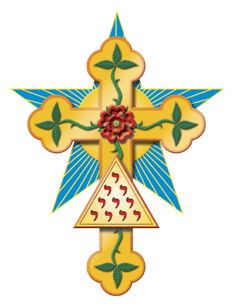
The Antioch Cross
As I look back over my life at the roadblocks that prevented me from becoming a priest in the Episcopal Church, as well as my years in the Roman Catholic Church, I see them as a blessing. I didn't understand at the time, but all of my frustrations and disappointments were God's crucible for tempering and preparing me for priesthood.
God had a plan for me and it was to lead me to where he wanted me to be: first, a priest in the Church of Antioch and now a priest in the Ascension Alliance that is a Community of Ascensionists.
However, God was not done with me yet. As a consequence of having been brought up in the Anglo-Catholic wing of the Episcopal Church and my theological education at St. Mary's Roman Catholic Seminary, both my spirituality and understanding of "Catholicism" and "Church" were traditionally orthodox to the degree some would call "conservative". In other words, I was an exoteric Catholic that means I was taught the mystical and esoteric such as New Age Religions, Kabbalah, the Divine Feminine, Theosophy, and Reincarnation, were sins to believe and the road to Hell if practiced.
Yet, I slowly became aware of how many bishops and priests in the Church of Antioch held such beliefs; and, I discovered why. As I dug into the history of the Church of Antioch, I found its Apostolic Succession had two sources. The first source was the Roman Catholic Church, through the Old Catholic Church, then through the Liberal Catholic Church, and finally to Archbishop Herman Adrian Spruit who received this line of Apostolic Succession (often called the Mathew Line of Succession) when he was ordained to the priesthood and consecrated to the episcopate.
However, the Church of Antioch also has a second line of Apostolic Succession through the Malabar Rite that is the Christianity carried to the Malabar region of India by St. Thomas the disciple of Jesus and by way of the Church at Antioch in Syria which is the first congregation of followers of Jesus to be called "Christians".
That said, it is this line of Apostolic Succession; specifically that of the Liberal Catholic Church in Australia, from which the Church of Antioch--and by extension the Ascension Alliance--receives their mystical and esoteric inheritance.
To make the proverbial long story short, it is through my priesthood in the Church of Antioch that I gradually became aware of the validity of the mystical and esoteric wings of Christianity including Catholic Christianity.
And, I am fortunate to have had knowledgeable tutors along the way including Archbishop Richard Gundry, Bishop Paul Clemens, most especially my mentor Archbishop Frank Bugee, and most recently Xenos, who guided my exploration and study that culminated not only in my mystical and esoteric beliefs but also in my book, Reincarnation for Christians: Evidence from Early Christian and Jewish Mystical Tradition.
SYMBOLISIM OF THE CROSS OF ANTIOCH
The Cross of Antioch presents a dynamic fusion of concepts in one harmonious image
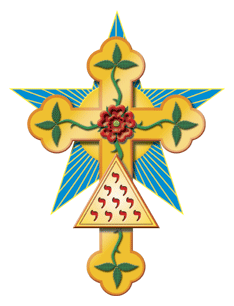
The Apostles Cross: First and foremost is the Apostles Cross, proclaiming the living power of the Christian faith.
Buds at the End of Each Arm of the Cross: The three buds at the end of each arm of the Cross symbolize the twelve Apostles. Additionally, they affirm the perpetual vitality of the apostolic teachings and gifts of the Spirit in the "four corners of the earth".
The Rose: The rose at the center of the Cross symbolizes the love of Christ, his redeeming sacrifice, and the fire of the Holy Spirit.
Green Branches and Leaves: The green branches and leaves upon the Cross show the love of Christ and the power of the Holy Spirit flowing from the central Rose to give life to the world, nurturing evolutionary and spiritual growth, and forming a channel that unites the celestial state and the material dimension in one bond of divine light.
The Golden Halo: The golden Halo of the Cross represents both the glory of Christ and the glory of the inner light of every person born into the world. This mystery is emphasized by the Halo's position at the center of the five-rayed Star.
The Five-Rayed Star: The five-rayed Star calls to mind the structure of the Temple of Solomon--the two lower rays of the Star representing the pillars, and the three upper rays representing the three chambers of the Temple edifice. The structure of the Star also suggests the twofold and threefold structure of the faculties of the psyche as set forth by St. Augustine.
Thus, in the present context, the Star is seen as an image of human spiritual nature considered the personal Temple of the Holy Spirit. However, the Star may also be seen as an image of human nature restored to its original and unsullied divine splendor; and just as the light of the Sun is scattered by the earth's atmosphere so that the sky is seen as blue, so too the Star is seen as blue because it is irradiated with the light of Christ's glory.
Triangle: The Triangle on the Lower Arm of the Cross contains an arrangement of digits known as the Tetractys or Pythagorean Decad. Tetractys is a philosophical paradigm which, from ancient times, has been seen as an emblem of the totality of existences and as an illustration of the progressive emanation of the categories and qualities of being from "the one" to "the many".
In relation to the Cross of Antioch, its pattern is composed of the Hebrew letter Yod repeated ten times. An affinity is hereby proclaimed with elements of the Kabbalah, the mystical tradition of Israel, in which the ten modality of being called Sephiroth are shown in dynamic interaction in an image known as the Tree of Life.
The position of the Tetractys within the Triangle reminds us that all the processes of creation, of manifest and increase, begin from, operate within, and are sustained by, the action of the Triune Godhead.
ST. JAMES CATHOLIC COMMUNITY
When I was ordained to the priesthood, I began St. James Catholic Community. St. James was an Internet ministry a part of which was the first weekly Internet Mass on the Internet. Over the years, St. James had several thousand viewers per week from many different countries including Canada, Ireland, Scotland, England, France, Germany, Belgium, Australia, and New Zealand as well as occasionally people from former client states of the Soviet Union. And, St. James was the only Catholic Rite denomination that reached our troops in Iraq and Afghanistan; who, becasue the Mass was perpetually on the website could participate regardless of the differences in time zones as well as their schedules.
After 15 years as pastor, I retired from that ministry on January 1, 2014. Consequently, my ministry now encompasses my faculty positions at Ascension Theological College and St. Michaels Divinity School, Australia, as well as writing books on political, religious, and social topics.